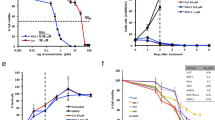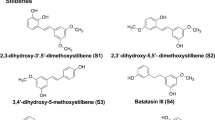Summary
Considering that as many as 80 % of the anticancer drugs have their roots in natural products derived from traditional medicine, we examined compounds other than curcumin from turmeric (Curcuma longa) that could exhibit anticancer potential. Present study describes the isolation and characterization of another turmeric-derived compound, β-sesquiphellandrene (SQP) that exhibits anticancer potential comparable to that of curcumin. We isolated several compounds from turmeric, including SQP, α-curcumene, ar-turmerone, α-turmerone, β-turmerone, and γ-turmerone, only SQP was found to have antiproliferative effects comparable to those of curcumin in human leukemia, multiple myeloma, and colorectal cancer cells. While lack of the NF-κB-p65 protein had no effect on the activity of SQP, lung cancer cells that expressed p53 were more susceptible to the cytotoxic effect of SQP than were cells that lacked p53 expression. SQP was also found to be highly effective in suppressing cancer cell colony formation and inducing apoptosis, as shown by assays of intracellular esterase activity, plasma membrane integrity, and cell-cycle phase. SQP was found to induce cytochrome c release and activate caspases that lead to poly ADP ribose polymerase cleavage. SQP exposure was associated with downregulation of cell survival proteins such cFLIP, Bcl-xL, Bcl-2, c-IAP1, and survivin. Furthermore, SQP was found to be synergistic with the chemotherapeutic agents velcade, thalidomide and capecitabine. Overall, our results indicate that SQP has anticancer potential comparable to that of curcumin.






Similar content being viewed by others
References
Singh S (2007) From exotic spice to modern drug? Cell 130(5):765–768. doi:10.1016/j.cell.2007.08.024
Newman DJ, Cragg GM (2012) Natural products as sources of new drugs over the 30 years from 1981 to 2010. J Nat Prod 75(3):311–335. doi:10.1021/np200906s
Aggarwal BB, Sung B (2009) Pharmacological basis for the role of curcumin in chronic diseases: an age-old spice with modern targets. Trends Pharmacol Sci 30(2):85–94. doi:10.1016/j.tips.2008.11.002
Gupta SC, Patchva S, Aggarwal BB (2013) Therapeutic roles of curcumin: lessons learned from clinical trials. AAPS J 15(1):195–218. doi:10.1208/s12248-012-9432-8
Aggarwal BB, Yuan W, Li S, Gupta SC (2013) Curcumin-free turmeric exhibits anti-inflammatory and anticancer activities: identification of novel components of turmeric. Mol Nutr Food Res 57(9):1529–1542. doi:10.1002/mnfr.201200838
Li S, Yuan W, Deng G, Wang P, Aggarwal BB (2011) Chemical composition and product quality control of turmeric (curcuma longa L.). Pharmaceutical Crops 2:28–54
Uehara S, Yasuda I, Takeya K, Itokawa H (1992) Terpenoids and curcuminoids of the rhizoma of curcuma xanthorrhiza roxb. Yakugaku Zasshi : Journal of the Pharmaceutical Society of Japan 112(11):817–823
Hu Y, Du Q, Tang Q (1998) Determination of chemical constituents of the volatile oil from curcuma longa by gas chromatography-mass spectrometry. Se pu = Chinese Journal of Chromatography/Zhongguo hua xue hui 16(6):528–529
Stahl E (1984) The essential oil from thymus praecox ssp. Arcticus growing in Iceland. Planta Med 50(2):157–160. doi:10.1055/s-2007-969659
Yamahara J, Hatakeyama S, Taniguchi K, Kawamura M, Yoshikawa M (1992) Stomachic principles in ginger. II. Pungent and anti-ulcer effects of low polar constituents isolated from ginger, the dried rhizoma of zingiber officinale roscoe cultivated in Taiwan. The absolute stereostructure of a new diarylheptanoid. Yakugaku Zasshi : Journal of the Pharmaceutical Society of Japan 112(9):645–655
Denyer CV, Jackson P, Loakes DM, Ellis MR, Young DA (1994) Isolation of antirhinoviral sesquiterpenes from ginger (zingiber officinale). J Nat Prod 57(5):658–662
Antonious GF, Kochhar TS (2003) Zingiberene and curcumene in wild tomato. Journal of Environmental science and Health Part B, Pesticides, Food Contaminants, and Agricultural Wastes 38(4):489–500. doi:10.1081/PFC-120021668
Wohlmuth H, Smith MK, Brooks LO, Myers SP, Leach DN (2006) Essential oil composition of diploid and tetraploid clones of ginger (zingiber officinale roscoe) grown in Australia. J Agric Food Chem 54(4):1414–1419. doi:10.1021/jf0521799
Mercke P, Bengtsson M, Bouwmeester HJ, Posthumus MA, Brodelius PE (2000) Molecular cloning, expression, and characterization of amorpha-4,11-diene synthase, a key enzyme of artemisinin biosynthesis in artemisia annua L. Arch Biochem Biophys 381(2):173–180. doi:10.1006/abbi.2000.1962
Ricci D, Fraternale D, Giamperi L, Bucchini A, Epifano F, Burini G, Curini M (2005) Chemical composition, antimicrobial and antioxidant activity of the essential oil of teucrium marum (lamiaceae). J Ethnopharmacol 98(1–2):195–200. doi:10.1016/j.jep.2005.01.022
Wang L, Jian S, Nan P, Zhong Y (2004) Chemical composition of the essential oil of elephantopus scaber from southern China. Zeitschrift fur Naturforschung C, Journal of Biosciences 59(5–6):327–329
Cho IH, Lee HJ, Kim YS (2012) Differences in the volatile compositions of ginseng species (panax sp.). J Agric Food Chem 60(31):7616–7622. doi:10.1021/jf301835v
Sirat HM, Basar N, Jani NA (2011) Chemical compositions of the rhizome oils of two alpinia species of Malaysia. Nat Prod Res 25(10):982–986. doi:10.1080/14786419.2010.529079
Sirat HM, Jani NA (2013) Chemical constituents of the leaf of alpinia mutica roxb. Nat Prod Res 27(16):1468–1470. doi:10.1080/14786419.2012.718772
Zhao J, Zhang JS, Yang B, Lv GP, Li SP (2010) Free radical scavenging activity and characterization of sesquiterpenoids in four species of curcuma using a TLC bioautography assay and GC-MS analysis. Molecules 15(11):7547–7557. doi:10.3390/molecules15117547
Lee KH, Kim BS, Keum KS, Yu HH, Kim YH, Chang BS, Ra JY, Moon HD, Seo BR, Choi NY, You YO (2011) Essential oil of curcuma longa inhibits Streptococcus mutans biofilm formation. J Food Sci 76(9):H226–H230. doi:10.1111/j.1750-3841.2011.02427.x
Matsuda H, Nakamura S, Iwami J, Li X, Pongpiriyadacha Y, Nakai M, Kubo M, Fukuyama Y, Yoshikawa M (2011) Invasion inhibitors of human fibrosarcoma HT 1080 cells from the rhizomes of zingiber cassumunar: structures of phenylbutanoids, cassumunols. Chem Pharm Bull 59(3):365–370
Jeena K, Liju VB, Kuttan R (2013) Antioxidant, anti-inflammatory and antinociceptive activities of essential oil from ginger. Indian J Physiol Pharmacol 57(1):51–62
Araujo L, Moujir LM, Rojas J, Rojas L, Carmona J, Rondon M (2013) Chemical composition and biological activity of conyza bonariensis essential oil collected in Merida, Venezuela. Nat Prod Commun 8(8):1175–1178
Mitsudomi T, Steinberg SM, Nau MM, Carbone D, D'Amico D, Bodner S, Oie HK, Linnoila RI, Mulshine JL, Minna JD, et al. (1992) p53 gene mutations in non-small-cell lung cancer cell lines and their correlation with the presence of ras mutations and clinical features. Oncogene 7(1):171–180
Prasad S, Yadav VR, Ravindran J, Aggarwal BB (2011) ROS and CHOP are critical for dibenzylideneacetone to sensitize tumor cells to TRAIL through induction of death receptors and downregulation of cell survival proteins. Cancer Res 71(2):538–549. doi:10.1158/0008-5472.CAN-10-3121
Prasad S, Yadav VR, Sung B, Reuter S, Kannappan R, Deorukhkar A, Diagaradjane P, Wei C, Baladandayuthapani V, Krishnan S, Guha S, Aggarwal BB (2012) Ursolic acid inhibits growth and metastasis of human colorectal cancer in an orthotopic nude mouse model by targeting multiple cell signaling pathways: chemosensitization with capecitabine. Clinical Cancer research : An Official Journal of the American Association for Cancer Research 18(18):4942–4953. doi:10.1158/1078-0432.CCR-11-2805
Yang J, Liu X, Bhalla K, Kim CN, Ibrado AM, Cai J, Peng TI, Jones DP, Wang X (1997) Prevention of apoptosis by Bcl-2: release of cytochrome c from mitochondria blocked. Science 275(5303):1129–1132
Gupta SC, Sung B, Kim JH, Prasad S, Li S, Aggarwal BB (2013) Multitargeting by turmeric, the golden spice: from kitchen to clinic. Mol Nutr Food Res 57(9):1510–1528. doi:10.1002/mnfr.201100741
Bayala B, Bassole IH, Gnoula C, Nebie R, Yonli A, Morel L, Figueredo G, Nikiema JB, Lobaccaro JM, Simpore J (2014) Chemical composition, antioxidant, anti-inflammatory and anti-proliferative activities of essential oils of plants from Burkina Faso. PLoS One 9(3):e92122. doi:10.1371/journal.pone.0092122
Piras A, Rosa A, Marongiu B, Atzeri A, Dessi MA, Falconieri D, Porcedda S (2012) Extraction and separation of volatile and fixed oils from seeds of myristica fragrans by supercritical CO(2): chemical composition and cytotoxic activity on caco-2 cancer cells. J Food Sci 77(4):C448–C453. doi:10.1111/j.1750-3841.2012.02618.x
Green DR, Reed JC (1998) Mitochondria and apoptosis. Science 281(5381):1309–1312
Wolter KG, Hsu YT, Smith CL, Nechushtan A, Xi XG, Youle RJ (1997) Movement of Bax from the cytosol to mitochondria during apoptosis. J Cell Biol 139(5):1281–1292
Thornberry NA, Lazebnik Y (1998) Caspases: enemies within. Science 281(5381):1312–1316
Darmon AJ, Nicholson DW, Bleackley RC (1995) Activation of the apoptotic protease CPP32 by cytotoxic T-cell-derived granzyme B. Nature 377(6548):446–448. doi:10.1038/377446a0
Prasad S, Ravindran J, Aggarwal BB (2010) NF-kappaB and cancer: how intimate is this relationship. Mol Cell Biochem 336(1–2):25–37. doi:10.1007/s11010-009-0267-2
Park SE, Min YK, Ha JD, Kim BT, Lee WG (2007) Novel small molecule induces p53-dependent apoptosis in human colon cancer cells. Biochem Biophys Res Commun 358(3):842–847. doi:10.1016/j.bbrc.2007.04.196
Jin S, Mazzacurati L, Zhu X, Tong T, Song Y, Shujuan S, Petrik KL, Rajasekaran B, Wu M, Zhan Q (2003) Gadd45a contributes to p53 stabilization in response to DNA damage. Oncogene 22(52):8536–8540. doi:10.1038/sj.onc.1206907
Schuler M, Bossy-Wetzel E, Goldstein JC, Fitzgerald P, Green DR (2000) p53 induces apoptosis by caspase activation through mitochondrial cytochrome c release. The Journal of Biological chemistry 275(10):7337–7342
Acknowledgments
The authors thank Amy L Ninetto from the Department of Scientific Publications for carefully editing the manuscript. This work was supported by a grant from the Center for Targeted Therapy of The University of Texas MD Anderson Cancer Center and Jarrow Formulas, CA. Dr. Aggarwal is the Ransom Horne, Jr., Professor of Cancer Research.
Author information
Authors and Affiliations
Corresponding author
Ethics declarations
Conflict of interest
The authors declare no conflict of interest.
Rights and permissions
About this article
Cite this article
Tyagi, A.K., Prasad, S., Yuan, W. et al. Identification of a novel compound (β-sesquiphellandrene) from turmeric (Curcuma longa) with anticancer potential: comparison with curcumin. Invest New Drugs 33, 1175–1186 (2015). https://doi.org/10.1007/s10637-015-0296-5
Received:
Accepted:
Published:
Issue Date:
DOI: https://doi.org/10.1007/s10637-015-0296-5




